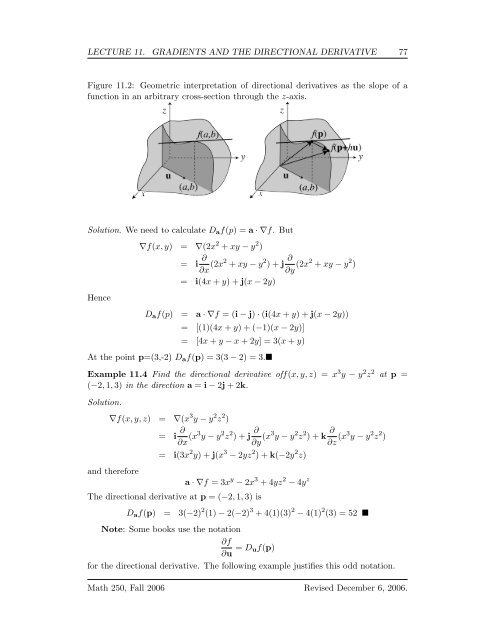Multivariate Calculus - Bruce E. Shapiro
Multivariate Calculus - Bruce E. Shapiro
Multivariate Calculus - Bruce E. Shapiro
Create successful ePaper yourself
Turn your PDF publications into a flip-book with our unique Google optimized e-Paper software.
LECTURE 11. GRADIENTS AND THE DIRECTIONAL DERIVATIVE 77<br />
Figure 11.2: Geometric interpretation of directional derivatives as the slope of a<br />
function in an arbitrary cross-section through the z-axis.<br />
Solution. We need to calculate D a f(p) = a · ∇f. But<br />
Hence<br />
∇f(x, y) = ∇(2x 2 + xy − y 2 )<br />
= i ∂<br />
∂x (2x2 + xy − y 2 ) + j ∂ ∂y (2x2 + xy − y 2 )<br />
= i(4x + y) + j(x − 2y)<br />
D a f(p) = a · ∇f = (i − j) · (i(4x + y) + j(x − 2y))<br />
= [(1)(4x + y) + (−1)(x − 2y)]<br />
= [4x + y − x + 2y] = 3(x + y)<br />
At the point p=(3,-2) D a f(p) = 3(3 − 2) = 3.<br />
Example 11.4 Find the directional derivative off(x, y, z) = x 3 y − y 2 z 2 at p =<br />
(−2, 1, 3) in the direction a = i − 2j + 2k.<br />
Solution.<br />
∇f(x, y, z) = ∇(x 3 y − y 2 z 2 )<br />
= i ∂<br />
∂x (x3 y − y 2 z 2 ) + j ∂ ∂y (x3 y − y 2 z 2 ) + k ∂ ∂z (x3 y − y 2 z 2 )<br />
and therefore<br />
= i(3x 2 y) + j(x 3 − 2yz 2 ) + k(−2y 2 z)<br />
a · ∇f = 3x y − 2x 3 + 4yz 2 − 4y z<br />
The directional derivative at p = (−2, 1, 3) is<br />
D a f(p) = 3(−2) 2 (1) − 2(−2) 3 + 4(1)(3) 2 − 4(1) 2 (3) = 52 <br />
Note: Some books use the notation<br />
∂f<br />
∂u = D uf(p)<br />
for the directional derivative. The following example justifies this odd notation.<br />
Math 250, Fall 2006 Revised December 6, 2006.
















